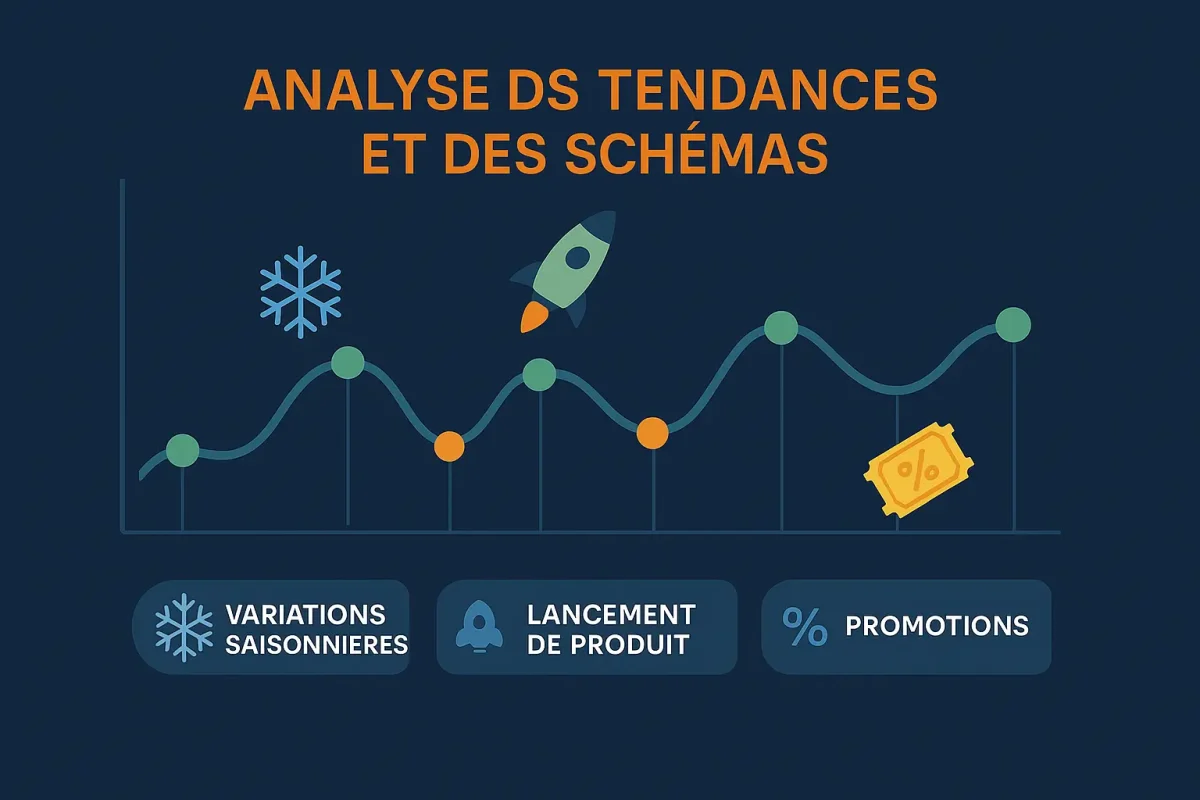Our modeling module analyzes historical data (sales, prices, promotions, etc.) in real time to create forecasting models, identifying trends, seasonal variations, the effects of product launches and other factors impacting sales performance.
The module enables you to estimate future demand for different products or product categories

In many sectors – retail, fashion, cosmetics, high-tech and pharmaceuticals – forecasting demand remains a major challenge. Sales fluctuate according to seasonality, special events, weather or product launches. Inaccurate forecasts lead either to overstocking and financial losses, or to stock-outs and a drop in sales.
An AI-driven forecasting and pricing module meets this challenge by analyzing sales histories and automatically selecting the most appropriate statistical model. It anticipates variations in consumption, adjusts prices to maximize margins in the event of strong demand, or triggers targeted promotions to limit overstocking.

AI-based models
Our AI solution makes your pricing decisions more reliable by analyzing your historical data, detecting seasonality and market trends, and continuously adjusting pricing recommendations for precise, sustainable optimization.
Using historical data and forecasting models, the module estimates future demand for different products or product categories. This helps you anticipate fluctuations in demand and adjust stock levels. But also to make informed pricing decisions to maximize their sales.
The Pricing Forecasting and Modeling module enables you to analyze trends and patterns in historical data, including sales, prices, promotions and more. It therefore allows detect seasonal variations, product launch effects. But also special events and other factors that can influence sales performance.
Our solution combines optimization and forecasting models to simulate different pricing scenarios, using forecasting models and testing the impact of different pricing strategies on your sales. automatically determine optimal prices while taking into account various requirements such as target margins, profitability objectives and competitive constraints. It also determines the optimal number of price changes, enabling you to avoid excessive adjustments while maximizing your margins, sales and competitive positioning. The result: more profitable and strategic pricing decisions.
Thanks to data analysis and forecasts, the pricing modeling and forecasting module identifies potential opportunities and risks linked to the pricing strategy. It can highlight products or product categories with high growth potential. As well as those that might require price adjustments to improve their performance.
Our pricing forecasting and modeling solution uses constrained reasoning models to automatically determine optimal prices while taking into account various requirements such as target margins, profitability objectives and competitive constraints.
Additionally, we provide models that estimate the optimal number of tariff ranks needed for each product category.
This allows you to effectively adjust your pricing strategy to the specific characteristics of each category.

The module integrates 8 statistical models (regression, ARIMA, Holt-Winters, etc.) and automatically selects the most appropriate based on your data. It analyzes historical data (ideally 3 years), seasonality and trends to guarantee reliable and relevant forecasts.
Once the optimal statistical model has been identified, the module applies it to the product-store concerned. It takes into account the specific characteristics of each product and each store to obtain accurate forecasts. This allows forecasts and pricing models to be adjusted to the specificities of each context, improving the relevance of results.
Other parameters may include adjustments for seasonality, trends, seasonal variations, etc. This feature makes it possible to customize forecasts according to the unique characteristics of each product-store, improving forecasting accuracy.
We offerintuitive setup allowing Data Analysts to customize models based on the specific needs of your business and market. Adjust parameters, constraints and variables to create forecasting and pricing models tailored to your business strategy.
So test different combinations of parameters and analyze the results to make informed decisions. Our version tracking system allows you to keep track of all changes made to pricing models.
We offer forecasting and pricing modeling models that analyze and prevent cannibalization between different types of brands.
So optimize your product assortment by avoiding pricing conflicts that could reduce your profit margins.
Our solution includes built-in models to measure the price elasticity of demand, helping you to understand how price variations can influence sales volumes.
In addition, our forecasting system allows us to estimate future sales volumes based on planned prices.
“The tool perfectly meets our users’ expectations, thanks to total transparency in its operation and settings.
Its management by exception and “typical week” approach have enabled us to optimize our forecasting and procurement efficiently. What’s more, integration into a standard ensures the stability and ongoing evolution of the solution, while respecting project deadlines and costs.”
Eric Gilbert
Purchasing Manager, Buffalo Grill
“Optimix is a high-performance, feature-rich solution that has improved our daily lives. Implementation was very quick, smooth and efficient.
Price management is now more efficient. We are continuing to develop the solution with functionalities adapted to our needs.
It’s essential for us to be able to keep pace with business requirements. I’m very satisfied with the collaboration, both during the deployment and today.”
Katarzyna Pieńkowska-Pawlik
Pricing Manager at Auchan Poland
“My experience in using the Optimix solution and working with the teams has been very positive.
This software has significantly improved our pricing decisions thanks to accurate information. We have benefited from a strong relationship with the OptimiX Solutions teams, and the rapid deployment in 6 months has reinforced our confidence in this successful collaboration.”
Mathieu Louchez
Pricing and Assortment Leader at Boulanger
“Thanks to the optimiX Solutions solution, we have not only reduced the number of errors, but also maximized our analysis capabilities, in particular for segmenting our competitors (BtoB, BtoC, etc.).
Our business teams managed to halve their alignment time, with increased productivity: over 12,000 products linked in just 3 minutes.
The solution is complete and covers our needs 360 degrees. The tool is ergonomic and price management is simplified.”
Jérémi Dusong
Pricing Project Manager at Bureau Vallée
Robustness, ease of use and adaptability are the pillars on which our solutions have been developed.
Reliable, high-performance, secure software
15 years of experience
Intuitive, 100% customizable interface
Strong expertise in Distribution
360° coverage of pricing issues
Expert, senior consultants
Single point of contact
100% in-house expertise

Want to model your sales for more reliable forecasts? Contact us !
Accueil / Pricing Solution – Optimize your pricing strategy / Sales modeling : How does our module work with AI?